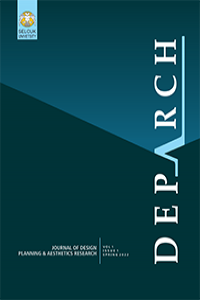Cognitive Phenomena of Style and Creativity
Cognitive Phenomena of Style and Creativity
___
- Aliseda A (2006) Abductive reasoning: logical investigations into discovery and explanation. vol 330. Springer, The Netherlands.
- Anderson JR (1980) Cognitive psychology and its implications. W. H. Freeman, San Francisco.
- Anderson JR, Bower GH (1973) Human associative memory. V. H. Winston & Sons, New York.
- Atkinson RC, Shiffrin RM (1968) Human memory: a proposed system and its control processes. In Spence KW, Spence JT (eds) The psychology of learning and motivation, vol 2, Academic, New York, pp 89-195)
- Boisvert DR (2011) Charles Leslie Stevenson. In: Zalta EN (ed) The Stanford Encyclopedia of Philosophy. http://plato.stanford.edu/archives/sum2011/entries/stevenson/. Accessed 14 August 2015.
- Bower GH (1970) Organizational factors in memory. Cognitive Psychology, 1:18-46.
- Brown T (2009) The making of a design thinker. Metropolis, October: 60-62.
- Byrne RMJ, Johnson-Laird (1989) Spatial reasoning. Journal of Memory and Language, 28(5): 564-575.
- Chan CS (1990) Cognitive processes in architectural design problem solving. Design Studies, 11(2):60-80.
- Chan CS (1992) Exploring individual style through Wright’s design. Journal of Architectural and Planning Research, 9(3):207-238.
- Chan CS (1993) How an individual style is generated? Environment and Planning B, 20(4):391-423.
- Chan CS (1994) Operational definition of style. Environment and Planning B, 21(2): 223-246.
- Chan CS (1997) Mental image and internal representation. Journal of Architectural and Planning Research, 14(1):52-77.
- Chan CS (2000) Can style be measured? Design Studies, 21(3):277-291.
- Chan CS (2001) An examination of the forces that generate a style. Design Studies 22(4):319-346.
- Chan CS (2011) Design Representation and Perception in Virtual Environments, In: Wang XY Tsai J (eds) Collaborative Design Virtual Environments, Springer, Amsterdam, pp 29-40.
- Chan CS (2012) Phenomenology of rhythm in design. Journal of Frontiers of Architectural Research, 1(3):253-258.
- Chan CS (2015) Style and creativity in design. Springer International Publishing, Switzerland.
- Cross N, Cross AC (1995) Observations of teamwork and social processes in design. Design Studies, 16: 143-170.
- Eastman (2001) New directions in design cognition: studies of representation and recall. In: Eastman C, McCracken M, Newsteller W (eds) Design knowing and learning. Elsevier, Amsterdam, pp 147-198.
- Echenique M (1972) Models: a discussion. In: Martin, L March L (eds) Urban space and structures. Cambridge University Press, Cambridge, pp 164-174.
- Goodridge J (1998) Rhythm and timing of movement in performance drama, dance and ceremony. Jessica Kingsley, London.
- Guilford JP (1950) Crativity. American Psychologist. 5:444-454.
- Guilford JP (1967) The nature of human intelligence. McGraw-Hill, New York.
- Hatch L (1988) Problem solving approach. In: Kemp WH, Schwaller AE (eds) Instructional strategies for technology education. Glencoe, Mission Hills.
- Kaplan C, Simon HA (1990) In search of insight. Cognitive Psychology, 22:374-419.
- Korf RE (1980) Toward a model of representational changes. Artificial Intelligence, 14:41-78.
- Kosslyn SM (1975) Information representation in visual images. Cognitive Psychology, 7: 341-370.
- Littlejohn D (1984) Architect, the life and work of Charles W Moore. Holt, Rinehart and Winston, New York.
- Magnani L (2009) Abductive cognition. The epistemological and eco-cognitive dimensions of hypothetical reasoning. Springer, Berlin/Heidelberg.
- Mithen S (2005) The singing Neanderthals: the origins of music, language, mind and body. Weidenfeld & Nicolson, London.
- Newell A, Simon HA (1972) Human problem solving. Prentice-Hall, Englewood Cliffs.
- Peirce CS (1997) Pragmatism as a principle and method of right thinking: the 1903 Harvard lectures on pragmatism. SUNY Press, Albany.
- Penfield W (2015) Mystery of the mind: a critical study of consciousness and the human brain. Princeton University Press, Princeton, NJ.
- Runco MA (1991) Divergent thinking. Ablex Publishing, Westport, CT.
- Schon DA (1983) The reflective practitioner. Temple-Smith, London.
- Torrance EP (1962) Guiding creative talent. Prentice Hall, Englewood Cliffs.
- Torrance EP (1966) Torrance tests of creativity. Personnel Press, Princeton.
- Wimmer GE, Shohamy D (2012) Preference by association: how memory mechanisms in the hippocampus bias decisions. Science 338(6104):270-273.
- Yeston M (1976) The stratification of musical rhythm. Yale University Press, New Heaven.
- Yayın Aralığı: Yılda 2 Sayı
- Başlangıç: 2022
- Yayıncı: Selçuk Üniversitesi
Genius Logi: Towards the Phenomenology of Gated Community
Özlem YILDIZ, Havva ALKAN BALA
Formaldehyde Emission in Different Positions of Wood-Based Boards Used in Interior Architecture
Kemal YILDIRIM, Hamza ÇINAR, Haldun Ender ERDEM
Cognitive Phenomena of Style and Creativity
Embodied Time: Applied and Incidental Architectural Narratives
Works of Art in the Turkish Grain Board (TMO) General Directorate Building
